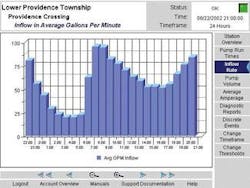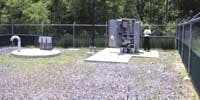New Internet-Based Diagnostic System Provides Lift Station Monitoring
By Tom Cicippio and Frank Pavlik
The Lower Providence Township Sewer Authority (LPTSA) in Montgomery County, PA, is responsible for operation of a collection system that includes 20 lift stations. The system receives sanitary sewage from the Township's residential, industrial and commercial customers, and delivers the sewage to a regional plant, Oaks Wastewater Treatment Plant operated by the Lower Perkiomen Valley Regional Sewer Authority.
LPTSA is typical of many wastewater utilities in that each lift station is inspected by utility personnel on a daily basis. Safety issues associated with the need for hazardous, confined-space entry during some of these inspections require two personnel. The inspections provide a degree of feedback as to the current health of the equipment, but there is always the risk that pump or pipe obstructions or equipment problems can create sewage overflows or major equipment damage between inspections. Also, the need to use available manpower for preventive maintenance, and for identification as well as elimination of I/I sources, provides further incentive to find better methods of lift station monitoring.
To help ease the burden on staff and improve monitoring performance, the authority recently installed an Internet-based monitoring system at two of its lift stations. The system, offered by ABB Inc., provides a variety of benefits. They include:
• Early detection and automated diagnosis/warning of pump equipment and lift station problems;
• More effective use of utility personnel through reduced inspection visits to remote lift stations;
• Lift station inflow rates and pumping rates (without flow meters) that can be used to identify I/I, exfiltration and obstruction problems in the collection system;
• Availability of historical data that helps in planning upgrades to lift station equipment and capacity, such as peak and average wastewater inflow rates and long term trends in inflow rates. A summary display containing daily totals of run time and flow for each pump and lift station is also included, and this data (in addition to flow rates, motor current usage, etc.) can be downloaded to a spreadsheet by the utility.
Internet-Based Diagnostic System
This Internet-based Lift Station Diagnostic and Information System (LSDIS) by ABB Inc. consists of equipment that is simple to install and cost effective to operate and maintain. Components at each lift station include a current sensor for each lift pump motor and, if applicable, one for the sump pump motor. A wall-mounted electronic node box accepts the motor current signals, and any discrete signals such as intrusion-type alarms, well level alarms, and power failure alarms.
The node box sends data to ABB's redundant and geographically separated database servers using only a local phone call via the utility's normal Internet Service Provider (ISP). In most cases, the existing phone line to the lift station can be used. A new phone line or cell phone modem can be installed if needed.
The database servers store and analyze the data and provide displays containing current and historical information at the server website (www.abb. com/lift-station).
Using motor current data plus plant information provided by the utility, the displays are configured by ABB to provide diagnostic information about the lift station. For example the website contains conclusions regarding pump run frequency and duration, pump motor current usage, station inflow and pump flow output for constant speed pumps, sump pump motor activation (for any station having a dry well), and alarms regarding lift station problems.
For a subscription fee, password-authorized utility personnel can access the website from different locations over a secure, encrypted Internet channel using a local phone call to the utility's normal ISP. Utility staff can use their own personal computers for this purpose, thereby eliminating the additional capital cost and ongoing maintenance cost of separate console equipment and software. Lift station alarms can also be sent to designated utility personnel via email-enabled text pagers or via email.
Automated Monitoring
When LPTSA installed the LSDIS equipment at its lift stations, one had been experiencing flooding problems. Data available through LSDIS is being used to verify the effectiveness of remedial measures to reduce I/I in that portion of the collection system. LPTSA also wanted to review the data to confirm possible problems with one of the pumps at that station.
Immediately upon installation of the LSDIS node box at the Providence Crossing Station, data corresponding to pump flow output and pump motor run time confirmed serious problems with pump #2. Data from the system demonstrated that prior to pump replacement between noon and 3 P.M. on 7/25/02:
1. Pump #2 run time was much longer than pump #1 runtime for each on-cycle, indicating that pump #2 was taking much longer than it should to pump down the wet well.
2. Pump #2 throughput (in gallons per minute) was much less than pump #1, indicating very inefficient operation.
The information indicated a serious pump obstruction. When pump #2 was removed from service, it was discovered that a metal plate was lodged in the pump and had partially obstructed the impeller, causing serious damage and forcing pump replacement. The subsequent installation of a properly functioning pump restored full pumping capacity to the lift station. Costly pump repairs in this case could have been avoided if the LSDIS equipment had been installed earlier.
Ongoing comparison of the LSDIS pump runtime graphs for the pumps at Providence Crossing Station compared to the pumps at the Mile Hill Station indicated that the Providence Crossing pumps were being cycled seven times more frequently than the Mile Hill pumps, and were running only about a third as long during each on-cycle.
Since frequent cycling of pumps and motors shortens operating life, and since the Providence Crossing pumps are larger and more costly to repair or replace, this was an important issue. Upon investigation, it was determined that the pump on/off control switches were 60% further apart vertically at the Mile Hill wet well, and consequently, LPTSA plans to investigate the feasibility of relocating the switches at Providence Crossing wet well.
Using LSDIS graphs, infiltration can also be analyzed by comparing trends in station inflow during dry weather and wet weather conditions. Inflow graphs for the Mile Hill Station indicated flow spikes which LPTSA is investigating. Possible causes for these spikes include malfunctioning on/off control switches, or illegal connections or dumping.
In addition to LSDIS display screens, messages are sent by LSDIS via email (as well as email-enabled text pagers) that alert the utility to potential problems at a specific lift station. These warning messages are derived by comparing recently measured or calculated values (and combinations of values) to a running average for the variables. For constant speed pumps, these diagnostics identify:
• Diminished wet well inflow rates (obstructed sewer main or exfiltration)
• Excessive wet well inflow rates (allow the utility to isolate those sections of their collection system experiencing infiltration)
• Diminished pump throughput
• Long pump run times
• Diminished or excessive current consumption
Other types of alerts provided for each lift station include:
• Non-alternating pump cycles
• Dual pump run events
• Dry pump run events
• Power failure
• High wet well level
• Intrusion alarm
• Sump pump operating (indicating water in the dry well)
In those situations where a lift station experiences dry pump run events and/or diminished pump throughput, the associated equipment is subjected to conditions that are not only harmful to the equipment but also wasteful of electricity.
However, even excluding such savings in power usage and also excluding reduced wastewater treatment fees saved by identifying sources of I/I, projected net savings from installing LSDIS are quite significant. Estimated efficiencies and net savings over a three-year period for a collection system like LPTSA are approximately $350,000 (over and above the purchase costs and installation costs of LSDIS), and are associated with:
1. Reduced inspection frequencies resulting in availability of inspection manpower for preventive maintenance, identification of infiltration sources, etc.
2. Use of flow calculated by the system in place of purchasing flow meters (e.g. for use in identifying sources of infiltration).
About the Authors: Tom Cicippio is Superintendent, Lower Providence Township Sewer Authority, located in Montgomery County, PA. He has been with the sewer authority for 11 years. Frank Pavlik has been a systems engineer and hands-on project leader involving use of systems and instrumentation for monitoring and control of process applications in utility, pharmaceutical and chemical industries over a 29-year career. His expertise includes the translation of customer requirements into system designs and software requirements.


